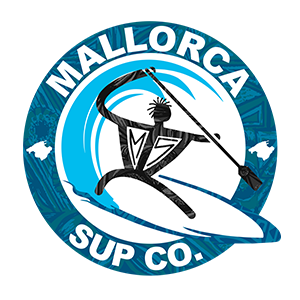.
Paddle boarding as we know it today, is steeped in history and heritage. The watermen of Hawaii are perhaps the most well known advocates, however - the humble stand up paddle board was actually first recorded thousands of years ago and has global notoriety.
The Ancient Early Adopters
Many many thousands of years ago, humans learnt to stand on two legs, but our desire to cross water never left our DNA.
The earliest recorded forms, date back over 3000 years, when Peruvian fishermen used crafts made of reeds to negotiate the pacific waves. Known as "Caballitos De Totora" (little horse made of reeds) they paddled using split bamboo shafts. Returning from successful fishing trips, they would catch the waves to propel them selves back to land.
Paddle boarding was even included in The Bible! When Moses was spotted floating in the River Nile in 1275 BC, Queen Bithia was travelling on a water craft. In order to find the baby, she stood up and paddled on it, to find Moses.
In the Middle East paddle boards date back to 800 AD and they were called Hasake. You can still find these boards today and they very much resemble the modern day SUP boards.
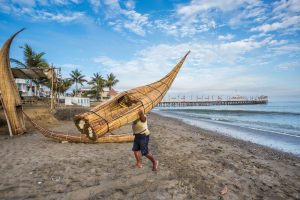
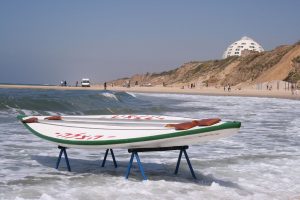
The Polynesian Connection
It is documented that until around 400AD the Islands of Hawaii were uninhabited. It was around this time that Polynesians, who were skilled mariners and had a history of exploration, left their islands to find new land, due to over population and war.
It is believed that they arrived on sturdy canoes that were adjoined with each other to created a well balanced craft, and used paddles to power the boats across the ocean. The first settlers arrived from the Marquesas Islands - some 2000 miles away. They first landed on the Big Island of Hawaii (the name deriving from the Polynesian name Havaiki, which means Homeland) at Ka Lae, which lies on the southern coast, and over the next 800 years or so, spread out to colonise every island. The settlers refined their water craft and travelled between islands on a single canoe, which they would stand on to propel themselves forward. This was for speed of movement, as well as to assist in the navigation.
This was first documented by outsiders in 1788 by Captain James Cook and his crew. He witnessed the villagers riding waves on carved Koa tree boards. It was tradition that that chief of the village would have the largest board - sometimes reaching up to 5 metres in length and due to the size, he would have to use a paddle.
Captain Cook returned to the Islands a year later during a religious festival, in which the Hawaiians welcomed him and his crew as gods. Having abused their hospitality for over a month, relationships became strained and when one of the crew died, exposing the fact that they were in fact mere mortals. The ship swiftly left but was forced to return to Hawaii due to storm damage, only this time they were greeted with anger. Tensions ran high and a battle ensued, in which the Captain was killed and only a few of his crew made it out alive and back to England.
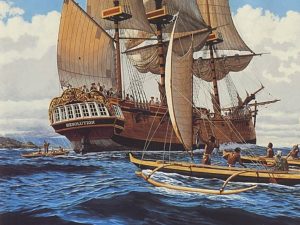
Making Waves In Waikiki
In the 1940's, the island of Waikiki was the epicentre of the advent of surf culture. Arguably the most famous surfer and all round legend - Duke Kahanamoku, together with AcChoy brothers, pioneered paddle boarding as we know it.
The Duke was already a Hawaiian legend. He was a long serving sheriff of Honolulu, getting re-elected 12 times between 1934 and 1960, by a community who adored him. The Duke was also an outstanding waterman, an Olympic swimmer and water polo player. Loved internationally, his fame also got him Hollywood notoriety.
During lessons, he - and the brothers would bring out their paddles and stand on their boards, to gain a better view of their students through the undulating swell of the Pacific Ocean. They were aptly named the Beach Boys.
It also provided Bobby AhChoy the ability to be out on the water after a car accident left him unable to kneel or swim. He also once stated that "it helped to keep his cigarettes dry".
Another famed Hawaiian resident - John Zapotock is considered the father of modern stand up surfing. Having moved to the Islands in the 1940’s, he was instantly inspired by The Waikiki Beach Boys.
John was one of the few outsiders to become an icon amongst the original beach boys and he rode the waves of Waikik on a SUP board for over 60 years and well in to his 90's. He eventually died at the grand old age of 95 - a true legend of the sport.
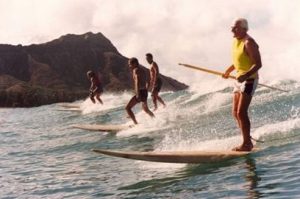
John Zapotocky
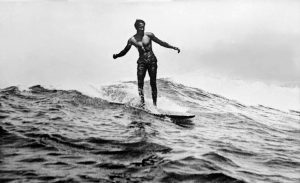
Duke Kahanamoku
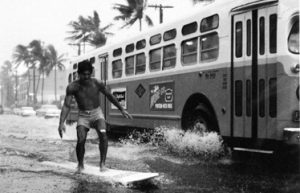
Bobby AhChoy
